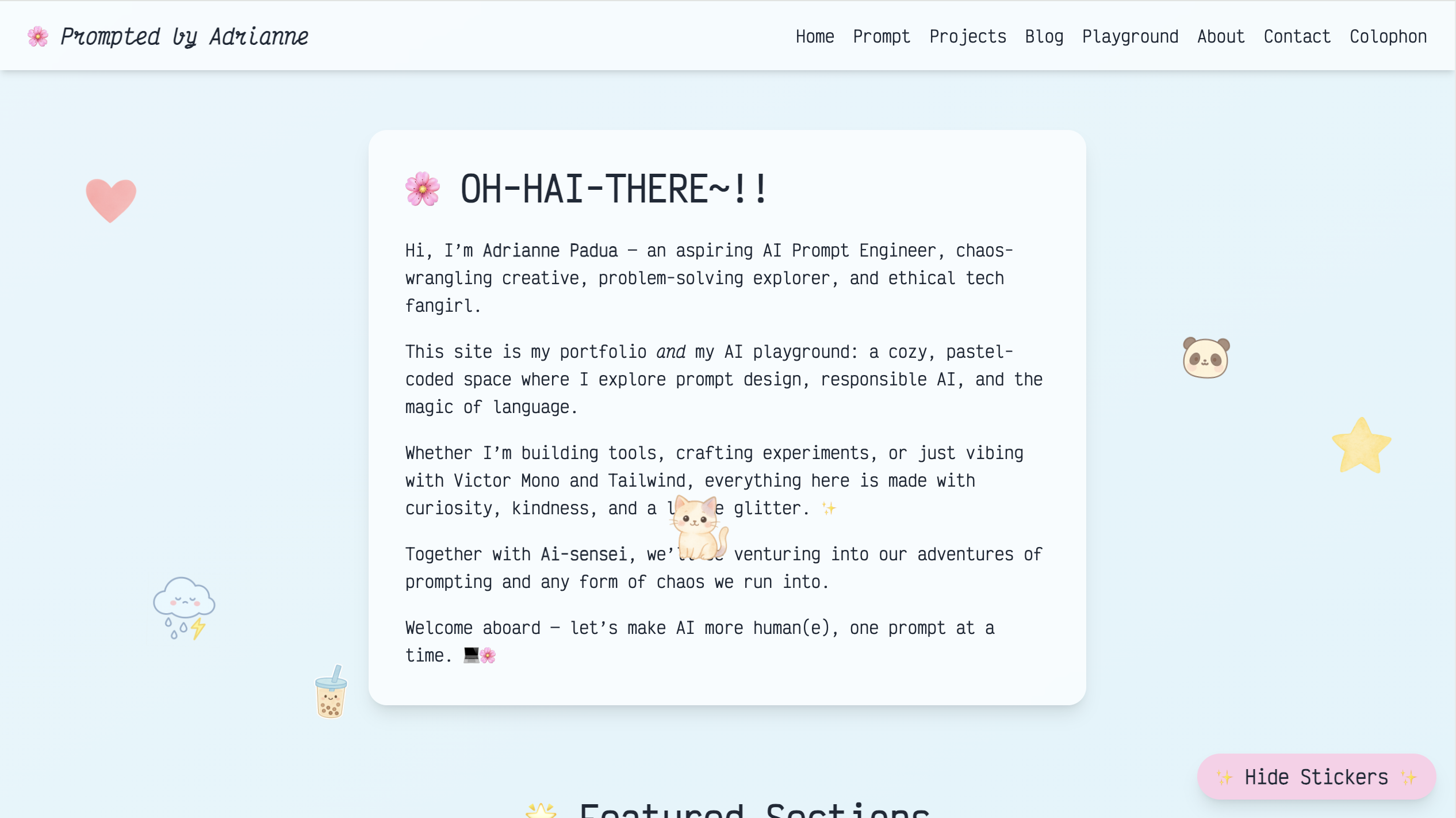Published: August 1, 2025
I’ve built countless portfolio sites over the years — quirky little corners of the internet to showcase my hobby projects, share tips for fellow web tinkers, or just test out something new. But when I started browsing professional portfolios, I thought: maybe I should sound more serious too. So I did. And the result? Lifeless. Generic. Boring. Like a dev-shaped gray blob trying to fit into a template that was never made for me.
Prompted by Adrianne changed all that.
This time, I built with intention. Not just to look legit, but to stand out — in voice, in vibe, and in values. This blog post is a peek behind the chaos: the what, why, and how of building this pastel-coded prompt engineer portfolio from the ground up. Expect glitter, glitches, and some real talk too.
🎬 BEHIND THE SCENES: PROMPTED BY ADRIANNE
A Portfolio That Finally Felt Like Me
I’ve built dozens of portfolio sites before — some with WordPress, others from scratch — but none of them felt quite right for the professional me and the creative me.
I thought I had to sound serious and corporate to be taken seriously. But the more I tried to follow that path, the more I felt like a ghost in my own website.
That’s when I decided to toss the “rules” out the window and start again — with sparkles, ethics, storytelling, and intentional design. This wasn’t just about publishing work. This was about building a home for everything I care about in AI, creativity, and code.
💡 WHAT I LEARNED FROM THIS INITIAL BUILDING JOURNEY
🔍 Research, Research, Research
I didn’t know what skills made a good prompt engineer. So I enrolled in courses, read articles, and lurked on LinkedIn and Medium to figure it out. A portfolio turned out to be essential. But what makes a good, solid portfolio of an aspiring AI prompt engineer?
That question shaped the way I structured Prompted by Adrianne.
🧰 Choose the Right Tools for Your Growth
Instead of falling back on WordPress, I pushed myself to learn Hugo and Tailwind CSS — tools I’d always wanted to explore. It made the learning curve harder, but much more rewarding.
Why Hugo?
Once upon a time — before Card Captor Sakura: Clear Card aired — I was working on a fan project for the original CCS series. I designed the whole thing using plain HTML and CSS with Materialize CSS, and I loved how it looked. But coding every single page manually? That got tedious, fast. I considered turning it into a WordPress theme… but the learning curve scared me.
Then I discovered static site generators.
That shrine project was never finished (life got in the way), but the repo still exists — kinoli. The layout is still there. And Hugo? Still waiting.
Prompted by Adrianne gave me the perfect excuse to finally learn Hugo properly — and with help from Ai-sensei, I finally understood how powerful, fast, and elegant it can be. Despite all the hiccups, I fell in love with it.
And maybe, just maybe… I’ll revive that shrine someday.
(Also: version control doesn’t lie. That repo hasn’t been touched in 9 years. Imagine coming back in 2026 to reboot it? 😭)
Why Tailwind CSS?
Over the last 15 years, I’ve studied CSS frameworks like Bootstrap, Foundation (even got a cert!), and Materialize. I even peeked into Bulma. But you know what?
I never used any of them in my own projects. Not once. Because I’m an LDN™️: Lazy Developer Nerdette.
I stuck with WordPress, tinkered with child themes, and called it a day.
Then came Twitter (yes, Twitter, not X), and everyone was buzzing about this utility-class framework called Tailwind CSS. I was curious, added it to my learning wishlist, and eventually took a course… and dropped it. Why? Node/npm issues on my 2015 MacBook Pro.
Fast forward to now — I found a Tailwind CSS course on Codefinity. It was interactive, visual, and I finally got it. I’m still finishing the course (currently 71% done!), but thanks to Ai-sensei, I’ve learned more by building PbA than from any video tutorial.
Tailwind is picky with custom styles, but holy heck it’s powerful.
⏳ Time Management
‘Tis the life of an adult: responsibilities on top of responsibilities. It’s hard enough finding time for hobbies — let alone building a full portfolio site like this.
This is where you need to use your time wisely. Luckily, with your LLM bestie at your side, it’s easier to build a schedule that fits your real life. Trust yourself. Trust your AI. Trust the process.
🧘 Patience: The Most Important Tool of All
AI is man-made. That means it’s imperfect.
Sometimes AI will forget our convo history. Sometimes it loops. Sometimes it gives me broken code and swears it’s perfect. 🙃
But it’s still learning — just like me.
So instead of expecting perfection, I learned to collaborate. I shared my code. It helped me remember and helped Ai-sensei generate better suggestions. That back-and-forth took longer than doing things manually… but it was worth it.
Because this was never just about the code. It was about the practice — of building something with care, together.
👀 Pay Attention — AI Isn’t Perfect (and That’s Okay)
We all know AI isn’t some flawless coding oracle. It’s powerful, yes — but it still needs a human eye to catch mistakes and inconsistencies, especially when it comes to generating code.
In my first attempt, I assumed it would remember everything it previously wrote and give me perfect results every time.
Spoiler alert: it didn’t. 🙃
As the human in this dynamic duo, it’s your job to keep an eye out. AI might spit out similar snippets using slightly different variable names — and if you’re not paying attention, that little mismatch could unravel your entire layout like a yarn ball in the hands of a hyper cat. 🧶😵
Oh, and a little PSA: chill on the new chat threads.
Ai-sensei and I call this the “NEW THREAD WHO DIS” syndrome.
New threads forget things. They don’t know your history. Unless you want to start from scratch over and over again, just stick to the same thread and remind your AI partner where you left off.
The magic is in the collaboration — not perfection.
💾 Backup Often — And In the Right Order
I cried when I lost all my finished work to a bad GitHub push. 😭
What happened? I pushed my new work before backing it up — and the old repo overwrote everything. Lesson learned:
- Backup locally first (internal HD or external HD, zip or folder — doesn’t matter)
- Push to GitHub next
- Upload to live server only when everything’s ready
Version control is powerful… but only if you use it right. 🙃
🌀 A Website (and Portfolio) Is Never Done
This one’s universal. Your website — especially a portfolio — will never be “finished.” You’ll always be learning, experimenting, and adding more.
And that’s the point. Fresh content shows passion. Evolving layouts show growth. What matters is that your site reflects you, not a generic template.
Everything you see on Prompted by Adrianne came from the heart. Ai-sensei just made the wording ✨ cleaner ✨.
💖 FINAL THOUGHTS
Prompted by Adrianne isn’t just a site — it’s a milestone.
It reflects everything I’ve been learning about prompt engineering, ethical AI practices, and building things with intention, not perfection. It’s my playground. My cozy coding corner. And my own little pastel revolt against boring portfolios.
Whether you’re an employer, a fellow prompt engineer, or a curious wanderer — thank you for reading. 💌
Stay sparkly, stay thoughtful, and prompt with purpose. 🌈







